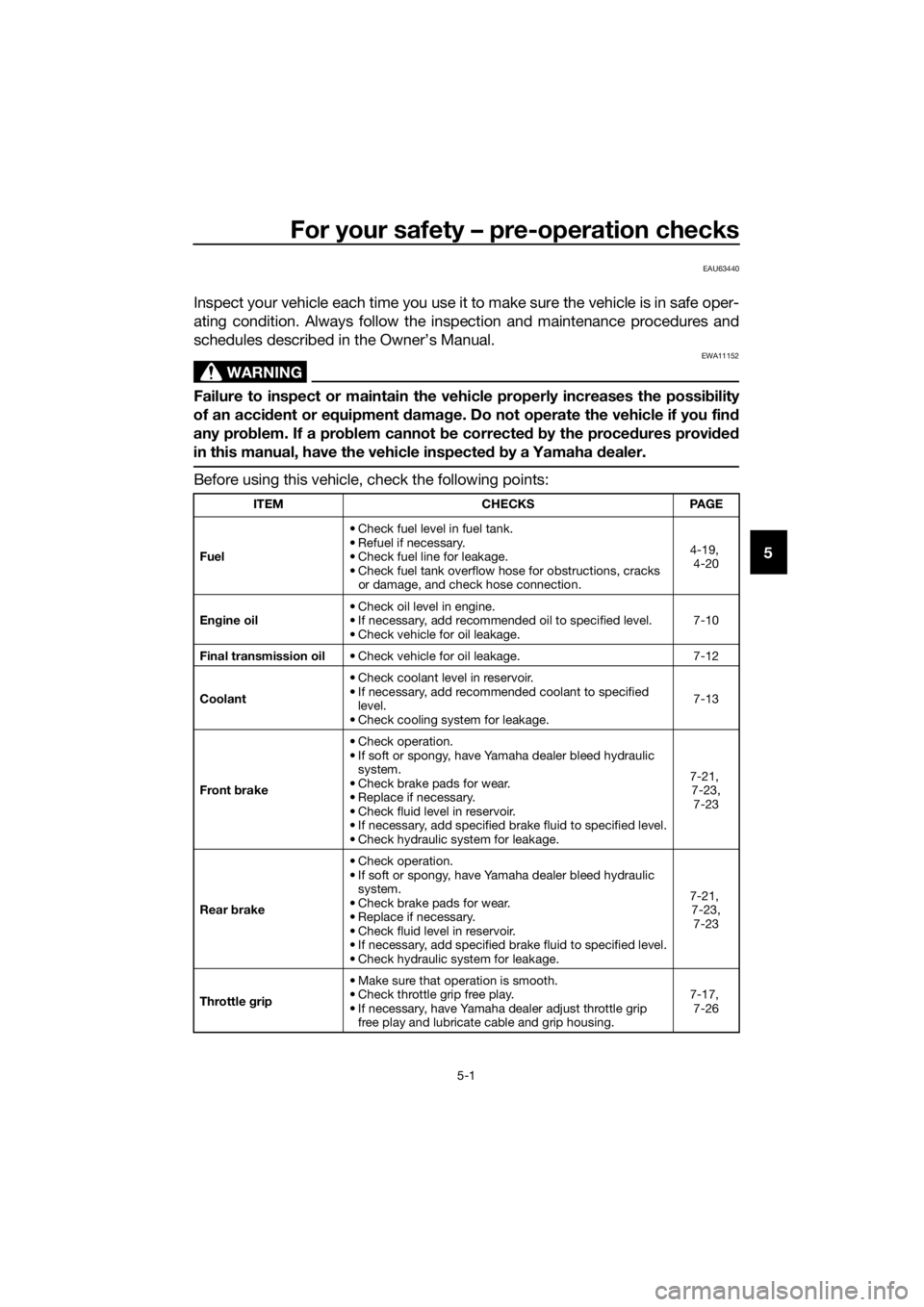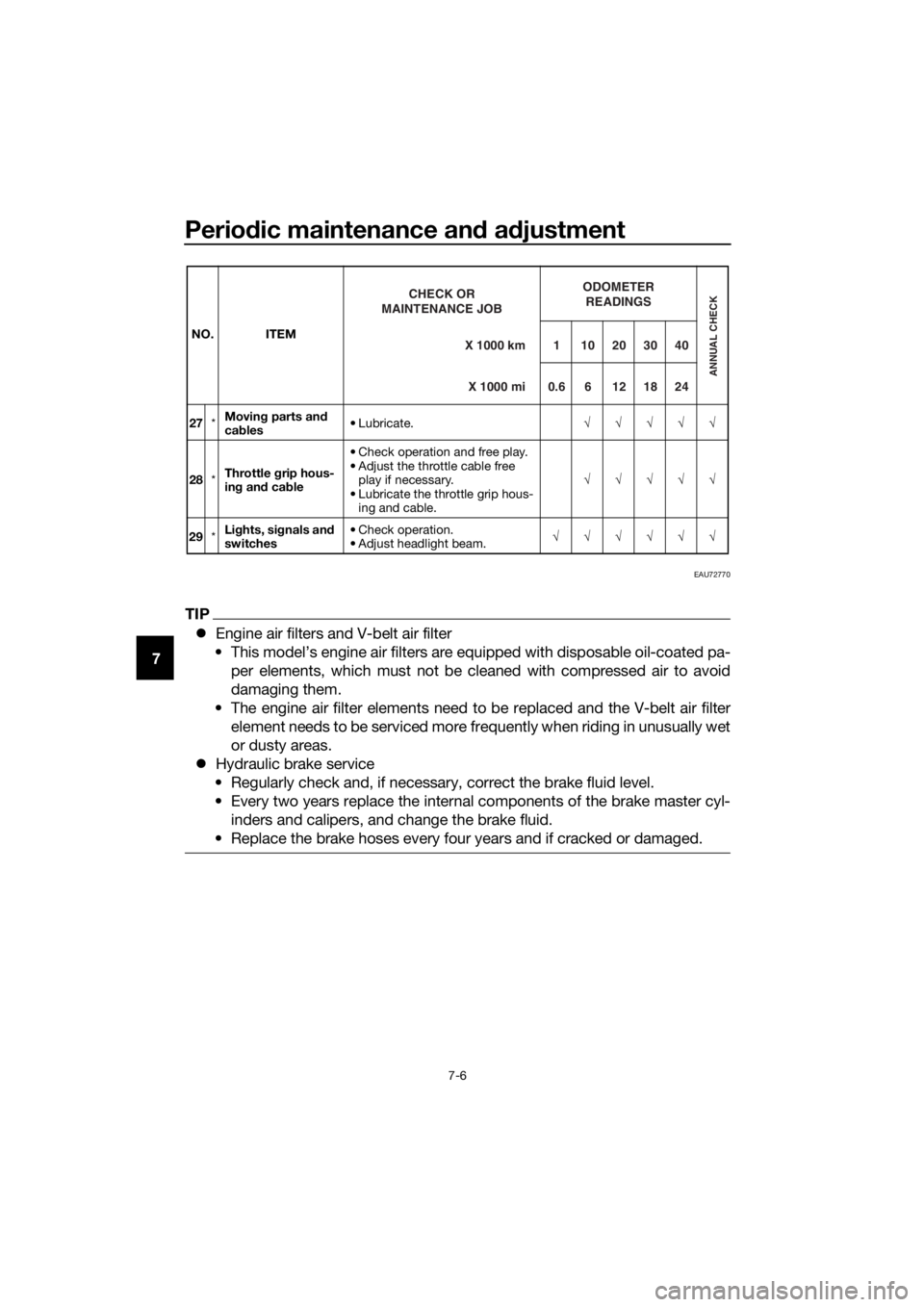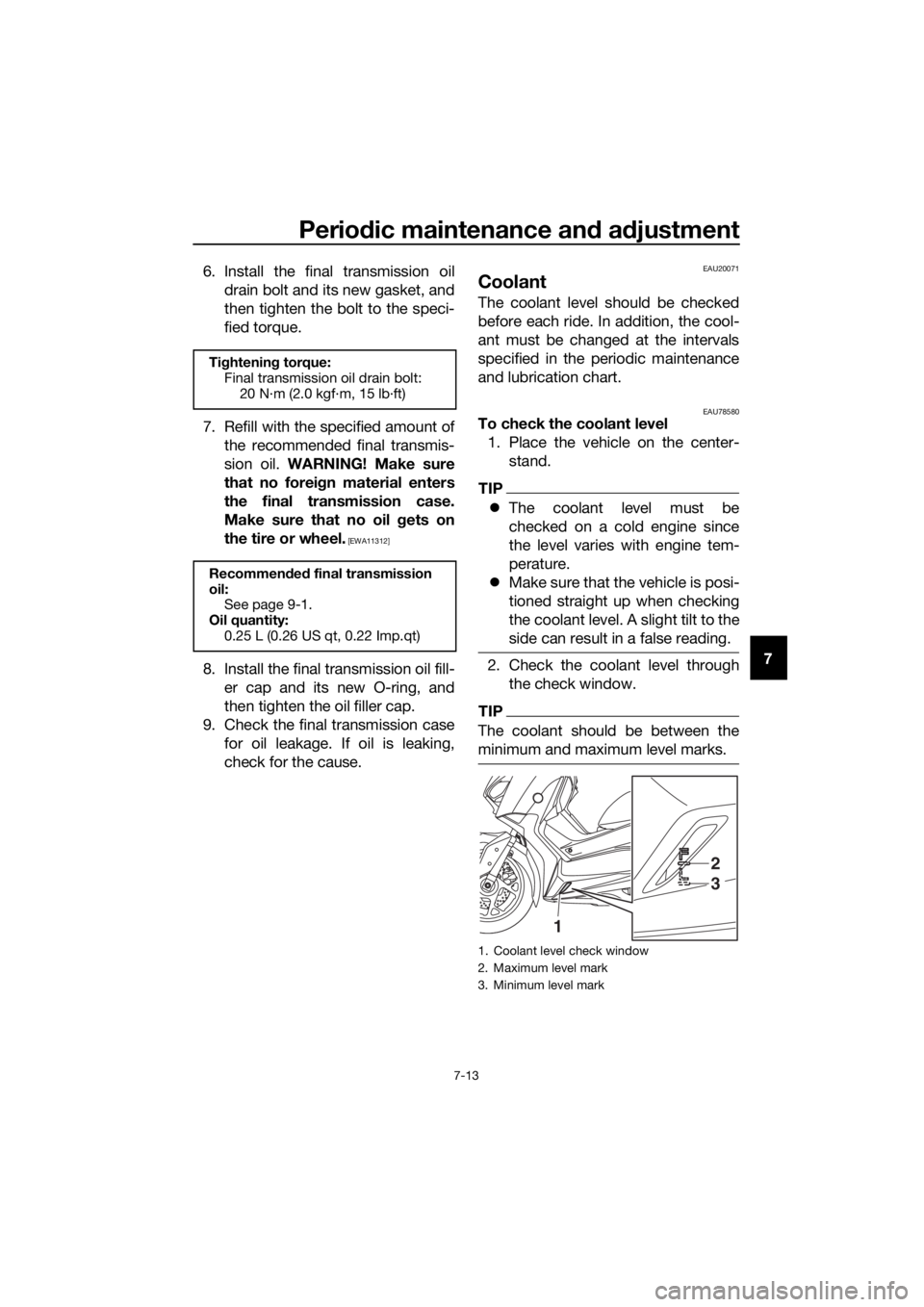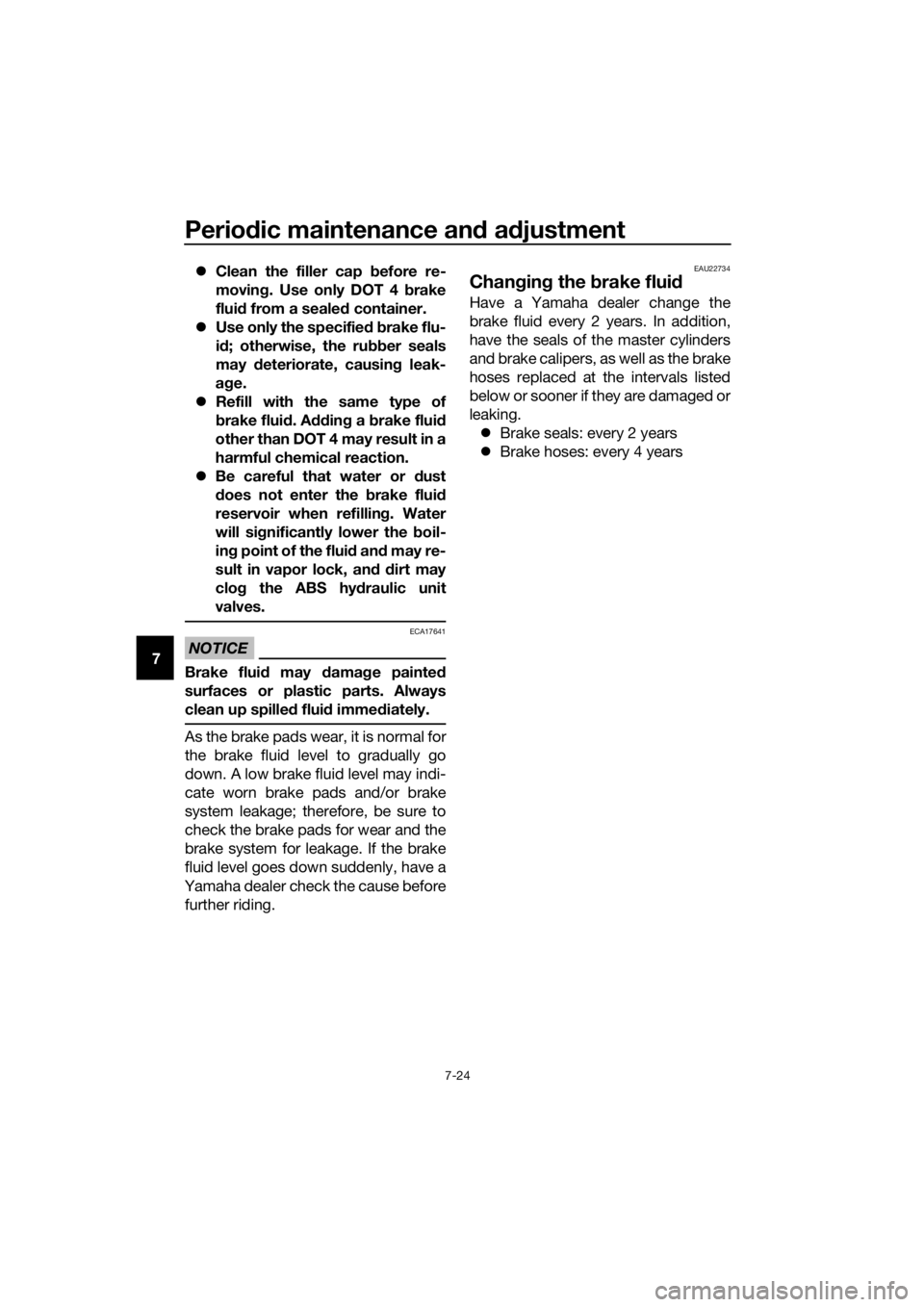oil level YAMAHA XMAX 400 2020 Owners Manual
[x] Cancel search | Manufacturer: YAMAHA, Model Year: 2020, Model line: XMAX 400, Model: YAMAHA XMAX 400 2020Pages: 118, PDF Size: 9.04 MB
Page 5 of 118

Table of contents
Safety information............................1-1
Further safe-riding points ................1-5
Description........................................2-1
Left view ..........................................2-1
Right view........................................2-2
Controls and instruments ................2-3
Smart key system ............................3-1
Smart key system............................3-1
Operating range of the smart key
system .........................................3-2
Handling of the smart key and
mechanical keys ..........................3-3
Smart key ........................................3-5
Replacing the smart key battery .....3-6
Main switch .....................................3-8
Instrument and control functions....4-1
Indicator lights and warning
lights ............................................4-1
Speedometer...................................4-2
Tachometer .....................................4-3
Multi-function display......................4-3
Handlebar switches.......................4-12
Front brake lever ...........................4-13
Rear brake lever ............................4-14
Rear brake lock lever ....................4-14
ABS ...............................................4-15
Traction control system.................4-16
Fuel tank cap.................................4-18
Fuel................................................4-19
Fuel tank overflow hose ................4-20
Catalytic converters .....................4-21
Storage compartments .................4-21
Windshield.....................................4-23
Handlebar position .......................4-26
Adjusting the shock absorber
assemblies .................................4-26
Sidestand ......................................4-27
Ignition circuit cut-off system........4-28
Auxiliary DC jack ..........................4-30For your safety – pre-operation
checks............................................... 5-1
Operation and important riding
points................................................. 6-1
Starting the engine.......................... 6-2
Starting off ...................................... 6-3
Acceleration and deceleration ........ 6-3
Braking............................................ 6-4
Tips for reducing fuel
consumption................................ 6-5
Engine break-in ............................... 6-5
Parking ............................................ 6-6
Periodic maintenance and
adjustment........................................ 7-1
Owner’s tool kit ............................... 7-2
Periodic maintenance chart for the
emission control system.............. 7-3
General maintenance and
lubrication chart........................... 7-4
Removing and installing panels ...... 7-7
Checking the spark plug ................. 7-8
Canister........................................... 7-9
Engine oil and oil filter element ..... 7-10
Final transmission oil .................... 7-12
Coolant ......................................... 7-13
Air filter elements and check
hoses and V-belt case air filter
element ...................................... 7-15
Checking the throttle grip free
play ............................................ 7-17
Valve clearance ............................. 7-18
Tires .............................................. 7-18
Cast wheels .................................. 7-20
Checking the front and rear brake
lever free play ............................ 7-21
Adjusting the rear brake lock
cable .......................................... 7-22
Checking the rear brake lock ........ 7-22
Checking the front and rear brake
pads........................................... 7-23
Checking the brake fluid level....... 7-23
Changing the brake fluid............... 7-24
Checking the V-belt ...................... 7-25
UBL1E0E0.book Page 1 Thursday, May 11, 2017 8:51 AM
Page 57 of 118

For your safety – pre-operation checks
5-1
5
EAU63440
Inspect your vehicle each time you use it to make sure the vehicle is in safe oper-
ating condition. Always follow the inspection and maintenance procedures and
schedules described in the Owner’s Manual.
WARNING
EWA11152
Failure to inspect or maintain the vehicle properly increases the possibility
of an accident or equipment damage. Do not operate the vehicle if you find
any problem. If a problem cannot be corrected by the procedures provided
in this manual, have the vehicle inspected by a Yamaha dealer.
Before using this vehicle, check the following points:
ITEM CHECKS PAGE
Fuel• Check fuel level in fuel tank.
• Refuel if necessary.
• Check fuel line for leakage.
• Check fuel tank overflow hose for obstructions, cracks
or damage, and check hose connection.4-19,
4-20
Engine oil• Check oil level in engine.
• If necessary, add recommended oil to specified level.
• Check vehicle for oil leakage.7-10
Final transmission oil• Check vehicle for oil leakage. 7-12
Coolant• Check coolant level in reservoir.
• If necessary, add recommended coolant to specified
level.
• Check cooling system for leakage.7-13
Front brake• Check operation.
• If soft or spongy, have Yamaha dealer bleed hydraulic
system.
• Check brake pads for wear.
• Replace if necessary.
• Check fluid level in reservoir.
• If necessary, add specified brake fluid to specified level.
• Check hydraulic system for leakage.7-21,
7-23,
7-23
Rear brake• Check operation.
• If soft or spongy, have Yamaha dealer bleed hydraulic
system.
• Check brake pads for wear.
• Replace if necessary.
• Check fluid level in reservoir.
• If necessary, add specified brake fluid to specified level.
• Check hydraulic system for leakage.7-21,
7-23,
7-23
Throttle grip• Make sure that operation is smooth.
• Check throttle grip free play.
• If necessary, have Yamaha dealer adjust throttle grip
free play and lubricate cable and grip housing.7-17,
7-26
UBL1E0E0.book Page 1 Thursday, May 11, 2017 8:51 AM
Page 69 of 118

Periodic maintenance and adjustment
7-5
7
14*Steering bearings• Check bearing assemblies for
looseness.√√ √
• Moderately repack with lithium-
soap-based grease.√√
15*Chassis fasteners• Make sure that all nuts, bolts
and screws are properly tight-
ened.√√√√√
16Front and rear
brake lever pivot
shaft• Lubricate with silicone grease.√√√√√
17Sidestand, center-
stand• Check operation.
• Lubricate with lithium-soap-
based grease.√√√√√
18*Sidestand switch• Check operation and replace if
necessary.√√√√√√
19*Front fork• Check operation and for oil
leakage.
• Replace if necessary.√√√√
20*Shock absorber
assemblies• Check operation and for oil
leakage.
• Replace if necessary.√√√√
21 Engine oil• Change (warm engine before
draining).
• Check oil level and vehicle for
oil leakage.At the initial interval and
when the oil change indi-
cator flashes or comes
on.√
22Engine oil filter el-
ement• Replace.√√√
23*Final transmission
oil• Check vehicle for oil leakage.√√√√√
• Change.√√√√√√
24
*Cooling system• Check coolant level and vehicle
for coolant leakage.√√√√√
• Change. Every 3 years
25*V-belt• Replace.When the V-belt replacement
indicator flashes [every 20000
km (12000 mi)]
26*Front and rear
brake switches• Check operation.√√√√√√ NO. ITEM
X 1000 km CHECK OR
MAINTENANCE JOB
X 1000 mi
ODOMETER
READINGS
ANNUAL CHECK
110203040
0.66121824
UBL1E0E0.book Page 5 Thursday, May 11, 2017 8:51 AM
Page 70 of 118

Periodic maintenance and adjustment
7-6
7
EAU72770
TIP
Engine air filters and V-belt air filter
• This model’s engine air filters are equipped with disposable oil-coated pa-
per elements, which must not be cleaned with compressed air to avoid
damaging them.
• The engine air filter elements need to be replaced and the V-belt air filter
element needs to be serviced more frequently when riding in unusually wet
or dusty areas.
Hydraulic brake service
• Regularly check and, if necessary, correct the brake fluid level.
• Every two years replace the internal components of the brake master cyl-
inders and calipers, and change the brake fluid.
• Replace the brake hoses every four years and if cracked or damaged.
27*Moving parts and
cables• Lubricate.√√√√√
28*Throttle grip hous-
ing and cable• Check operation and free play.
• Adjust the throttle cable free
play if necessary.
• Lubricate the throttle grip hous-
ing and cable.√√√√√
29*Lights, signals and
switches• Check operation.
• Adjust headlight beam.√√√√√√ NO. ITEM
X 1000 km CHECK OR
MAINTENANCE JOB
X 1000 miODOMETER
READINGS
ANNUAL CHECK
110203040
0.6 6 12 18 24
UBL1E0E0.book Page 6 Thursday, May 11, 2017 8:51 AM
Page 74 of 118

Periodic maintenance and adjustment
7-10
7
EAUM3940
Engine oil and oil filter ele-
ment
The engine oil level should be checked
before each ride. In addition, the oil
must be changed and the oil filter ele-
ment replaced at the intervals specified
in the periodic maintenance and lubri-
cation chart and when the oil change
indicator comes on.
To check the engine oil level
1. Place the vehicle on the center-
stand. A slight tilt to the side can
result in a false reading.
2. Start the engine, warm it up for
several minutes, and then turn it
off.
3. Wait a few minutes until the oil set-
tles, remove the oil filler cap, wipe
the dipstick clean, insert it back
into the oil filler hole (without
screwing it in), and then remove it
again to check the oil level.
TIP
The engine oil should be between the
tip of the dipstick and the maximum
level mark.
4. If the engine oil is not between the
tip of the dipstick and the maxi-
mum level mark, add sufficient oil
of the recommended type to raise
it to the correct level.
5. Insert the dipstick into the oil filler
hole, and then tighten the oil filler
cap.
To change the engine oil (with or
without oil filter element replace-
ment)
1. Place the vehicle on the center-
stand.
2. Start the engine, warm it up for
several minutes, and then turn it
off.
3. Place an oil pan under the engine
to collect the used oil.
4. Remove the engine oil filler cap,
the engine oil drain bolt and its
gasket to drain the oil from the
crankcase.
TIP
Skip steps 5…7 if the oil filter element is
not being replaced.
5. Remove the oil filter element cover
by removing the bolts. NOTICE:
When removing the oil filter ele-1. Engine oil filler cap
2. Dipstick
3. Maximum level mark
4. Tip of the engine oil dipstick
ZAUM1028
3
4
1
2
1. Engine oil drain bolt
2. Gasket
12
UBL1E0E0.book Page 10 Thursday, May 11, 2017 8:51 AM
Page 77 of 118

Periodic maintenance and adjustment
7-13
7 6. Install the final transmission oil
drain bolt and its new gasket, and
then tighten the bolt to the speci-
fied torque.
7. Refill with the specified amount of
the recommended final transmis-
sion oil. WARNING! Make sure
that no foreign material enters
the final transmission case.
Make sure that no oil gets on
the tire or wheel.
[EWA11312]
8. Install the final transmission oil fill-
er cap and its new O-ring, and
then tighten the oil filler cap.
9. Check the final transmission case
for oil leakage. If oil is leaking,
check for the cause.
EAU20071
Coolant
The coolant level should be checked
before each ride. In addition, the cool-
ant must be changed at the intervals
specified in the periodic maintenance
and lubrication chart.
EAU78580To check the coolant level
1. Place the vehicle on the center-
stand.
TIP
The coolant level must be
checked on a cold engine since
the level varies with engine tem-
perature.
Make sure that the vehicle is posi-
tioned straight up when checking
the coolant level. A slight tilt to the
side can result in a false reading.
2. Check the coolant level through
the check window.
TIP
The coolant should be between the
minimum and maximum level marks.
Tightening torque:
Final transmission oil drain bolt:
20 N·m (2.0 kgf·m, 15 lb·ft)
Recommended final transmission
oil:
See page 9-1.
Oil quantity:
0.25 L (0.26 US qt, 0.22 Imp.qt)
1. Coolant level check window
2. Maximum level mark
3. Minimum level mark
1
2
3
UBL1E0E0.book Page 13 Thursday, May 11, 2017 8:51 AM
Page 88 of 118

Periodic maintenance and adjustment
7-24
7Clean the filler cap before re-
moving. Use only DOT 4 brake
fluid from a sealed container.
Use only the specified brake flu-
id; otherwise, the rubber seals
may deteriorate, causing leak-
age.
Refill with the same type of
brake fluid. Adding a brake fluid
other than DOT 4 may result in a
harmful chemical reaction.
Be careful that water or dust
does not enter the brake fluid
reservoir when refilling. Water
will significantly lower the boil-
ing point of the fluid and may re-
sult in vapor lock, and dirt may
clog the ABS hydraulic unit
valves.NOTICE
ECA17641
Brake fluid may damage painted
surfaces or plastic parts. Always
clean up spilled fluid immediately.
As the brake pads wear, it is normal for
the brake fluid level to gradually go
down. A low brake fluid level may indi-
cate worn brake pads and/or brake
system leakage; therefore, be sure to
check the brake pads for wear and the
brake system for leakage. If the brake
fluid level goes down suddenly, have a
Yamaha dealer check the cause before
further riding.
EAU22734
Changing the brake fluid
Have a Yamaha dealer change the
brake fluid every 2 years. In addition,
have the seals of the master cylinders
and brake calipers, as well as the brake
hoses replaced at the intervals listed
below or sooner if they are damaged or
leaking.
Brake seals: every 2 years
Brake hoses: every 4 years
UBL1E0E0.book Page 24 Thursday, May 11, 2017 8:51 AM
Page 91 of 118

Periodic maintenance and adjustment
7-27
7
EAU23215
Checking and lubricating the
centerstand and sidestand
The operation of the centerstand and
sidestand should be checked before
each ride, and the pivots and metal-to-
metal contact surfaces should be lubri-
cated if necessary.
WARNING
EWA10742
If the centerstand or sidestand does
not move up and down smoothly,
have a Yamaha dealer check or re-
pair it. Otherwise, the centerstand or
sidestand could contact the ground
and distract the operator, resulting
in a possible loss of control.
EAU23273
Checking the front fork
The condition and operation of the
front fork must be checked as follows
at the intervals specified in the periodic
maintenance and lubrication chart.
To check the condition
Check the inner tubes for scratches,
damage and excessive oil leakage.
To check the operation
1. Place the vehicle on a level sur-
face and hold it in an upright posi-
tion. WARNING! To avoid injury,
securely support the vehicle so
there is no danger of it falling
over.
[EWA10752]
2. While applying the front brake,
push down hard on the handle-
bars several times to check if the
front fork compresses and re-
bounds smoothly.
NOTICE
ECA10591
If any damage is found or the front
fork does not operate smoothly,
have a Yamaha dealer check or re-
pair it.
1. Sidestand
1. Centerstand
Recommended lubricant:
Lithium-soap-based grease
ZAUM1033
1
UBL1E0E0.book Page 27 Thursday, May 11, 2017 8:51 AM
Page 109 of 118

Specifications
9-1
9
Dimensions:
Overall length:
2185 mm (86.0 in)
Overall width:
766 mm (30.2 in)
Overall height:
1415/1465 mm (55.7/57.7 in)
Seat height:
800 mm (31.5 in)
Wheelbase:
1567 mm (61.7 in)
Ground clearance:
90 mm (3.54 in)
Minimum turning radius:
2.5 m (8.20 ft)
Weight:
Curb weight:
210 kg (463 lb)
Engine:
Combustion cycle:
4-stroke
Cooling system:
Liquid cooled
Valve train:
DOHC
Number of cylinders:
Single cylinder
Displacement:
395 cm³
Bore × stroke:
83.0 × 73.0 mm (3.27 × 2.87 in)
Compression ratio:
10.6 : 1
Starting system:
Electric starter
Lubrication system:
Wet sump
Engine oil:
Recommended brand:
YAMALUBE
SAE viscosity grades:
10W-40
Recommended engine oil grade:
API service SG type or higher, JASO
standard MA
Engine oil quantity:
Oil change:
1.50 L (1.59 US qt, 1.32 Imp.qt)
With oil filter removal:
1.70 L (1.80 US qt, 1.50 Imp.qt)
Final transmission oil:
Type:
YAMALUBE 10W-40 or SAE 10W-30 type
SE motor oil
Quantity:
0.25 L (0.26 US qt, 0.22 Imp.qt)
Coolant quantity:
Coolant reservoir (up to the maximum level
mark):
0.18 L (0.19 US qt, 0.16 Imp.qt)
Radiator (including all routes):
1.30 L (1.37 US qt, 1.14 Imp.qt)
Air filter:
Air filter element:
Oil-coated paper element
Fuel:
Recommended fuel:
Premium unleaded gasoline (Gasohol [E10]
acceptable)
Fuel tank capacity:
13 L (3.4 US gal, 2.9 Imp.gal)
Fuel reserve amount:
2.4 L (0.63 US gal, 0.53 Imp.gal)
Fuel injection:
Throttle body:
ID mark:
B741 00
Spark plug(s):
Manufacturer/model:
NGK/CR7E
Spark plug gap:
0.7–0.8 mm (0.028–0.031 in)
Clutch:
Clutch type:
Dry, centrifugal, shoe
Drivetrain:
Primary reduction ratio:
1.000
Final drive:
Gear
Secondary reduction ratio:
6.643 (31/14 x 42/14)
Transmission type:
V-belt automatic
Chassis:
Frame type:
Underbone
Caster angle:
26.5 °
UBL1E0E0.book Page 1 Thursday, May 11, 2017 8:51 AM
Page 114 of 118

11-1
11
Index
A
ABS ....................................................... 4-15
ABS warning light ................................... 4-1
Acceleration and deceleration ................ 6-3
Air filter elements and check hoses and
V-belt case air filter element ............... 7-15
Auxiliary DC jack ................................... 4-30
Auxiliary lights ....................................... 7-32
B
Battery .................................................. 7-29
Brake fluid, changing ............................ 7-24
Brake fluid level, checking .................... 7-23
Brake lever, front .................................. 4-13
Brake lever, rear.................................... 4-14
Brake levers, lubricating ....................... 7-26
Brake/tail light ....................................... 7-33
Braking.................................................... 6-4
C
Cables, checking and lubricating ......... 7-25
Canister................................................... 7-9
Care ........................................................ 8-1
Catalytic converters .............................. 4-21
Centerstand and sidestand, checking
and lubricating .................................... 7-27
Coolant ................................................. 7-13
D
Data recording, vehicle ......................... 10-2
Diagnostic connectors .......................... 10-2
Dimmer/Pass switch ............................. 4-12
E
Emergency mode.................................. 7-38
Engine break-in....................................... 6-5
Engine oil and oil filter element ............. 7-10
Engine serial number ............................ 10-1
Engine trouble warning light ................... 4-1
F
Final transmission oil ............................ 7-12
Front and rear brake lever free play,
checking ............................................. 7-21
Front and rear brake pads, checking.... 7-23
Front fork, checking .............................. 7-27
Front turn signal light ............................ 7-33
Fuel ....................................................... 4-19
Fuel consumption, tips for reducing ....... 6-5
Fuel tank cap ........................................ 4-18
Fuel tank overflow hose ........................ 4-20
Fuses, replacing.................................... 7-30
H
Handlebar position, adjusting ............... 4-26
Handlebar switches .............................. 4-12Hazard switch....................................... 4-12
Headlights ............................................ 7-32
High beam indicator light ....................... 4-1
Horn switch .......................................... 4-12
I
Identification numbers .......................... 10-1
Ignition circuit cut-off system............... 4-28
Indicator lights and warning lights ......... 4-1
K
Key, handling of smart and mechanical
keys ...................................................... 3-3
L
License plate light bulb, replacing........ 7-34
M
Main switch ............................................ 3-8
Maintenance and lubrication, periodic ... 7-4
Maintenance, emission control
system.................................................. 7-3
Matte color, caution ............................... 8-1
Model label ........................................... 10-1
Multi-function display ............................. 4-3
O
Operating range of the smart key
system.................................................. 3-2
P
Panels, removing and installing.............. 7-7
Parking ................................................... 6-6
Part locations ......................................... 2-1
R
Rear brake lock cable, adjusting .......... 7-22
Rear brake lock, checking .................... 7-22
Rear brake lock lever............................ 4-14
S
Safe-riding points ................................... 1-5
Safety information .................................. 1-1
Shock absorber assemblies,
adjusting............................................. 4-26
Sidestand ............................................. 4-27
Smart key ............................................... 3-5
Smart key battery, replacing .................. 3-6
Smart key system ................................... 3-1
Smart key system indicator light ............ 4-2
Smart key system, troubleshooting...... 7-35
Spark plug, checking ............................. 7-8
Specifications ......................................... 9-1
Speedometer .......................................... 4-2
Starting off.............................................. 6-3
Starting the engine ................................. 6-2
Steering, checking................................ 7-28
Stop/Run/Start switch .......................... 4-12
UBL1E0E0.book Page 1 Thursday, May 11, 2017 8:51 AM